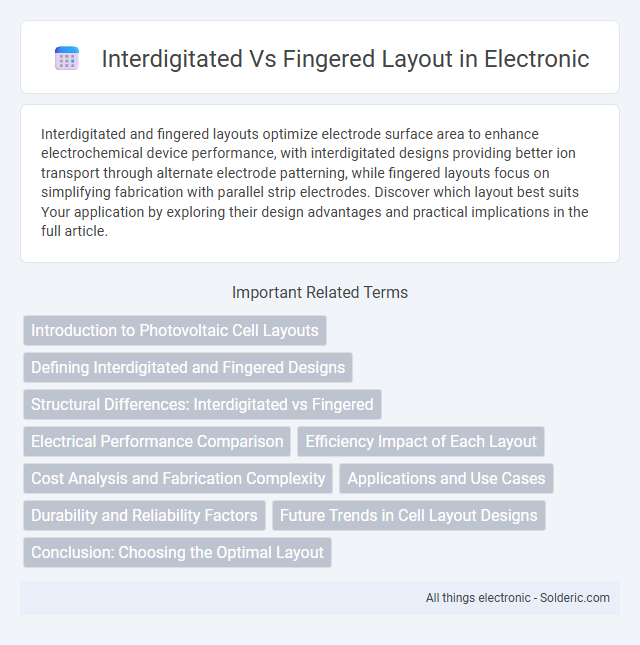Interdigitated and fingered layouts optimize electrode surface area to enhance electrochemical device performance, with interdigitated designs providing better ion transport through alternate electrode patterning, while fingered layouts focus on simplifying fabrication with parallel strip electrodes. Discover which layout best suits Your application by exploring their design advantages and practical implications in the full article.
Comparison Table
| Feature | Interdigitated Layout | Fingered Layout |
|---|---|---|
| Design Structure | Alternating interlocked fingers from two electrodes | Parallel fingers extending from a common busbar |
| Application | Capacitors, sensors, lubricated surface contacts | Capacitors, solar cells, microelectromechanical systems |
| Capacitance Density | Higher due to increased overlap and interlocking fingers | Moderate to high depending on finger length and width |
| Fabrication Complexity | Moderate; requires precise alignment for interlocking | Lower; simpler parallel patterning |
| Electric Field Distribution | Uniform field between interdigitated fingers | Less uniform; concentrated at finger edges |
| Resistance | Lower resistance due to shorter path between electrodes | Higher resistance depending on finger length |
| Performance | Optimized for high sensitivity and capacitance | Optimized for ease of manufacturing and scalability |
Introduction to Photovoltaic Cell Layouts
Photovoltaic cell layouts, including interdigitated and fingered designs, critically impact solar panel efficiency by influencing current collection and shading effects. Interdigitated layouts feature alternating positive and negative contacts arranged like interlocking fingers, minimizing resistive losses and enhancing electron flow. Fingered layouts utilize multiple narrow fingers extending from busbars to collect charges but may experience higher shading and resistive losses compared to interdigitated layouts.
Defining Interdigitated and Fingered Designs
Interdigitated and fingered layouts refer to specific electrode pattern designs commonly used in sensors and energy devices to optimize performance. Interdigitated designs feature alternating, comb-like electrodes interlocked between one another, enhancing the active area and sensitivity by maximizing electrode interface. Fingered designs consist of parallel electrode fingers extending from a common base, providing streamlined current paths and facilitating efficient charge collection.
Structural Differences: Interdigitated vs Fingered
Interdigitated layouts feature alternating electrode fingers that overlap evenly, optimizing surface area and electric field distribution for enhanced performance in devices like sensors and capacitors. Fingered layouts consist of parallel electrode fingers extending from separate terminals without overlapping, resulting in simpler fabrication but reduced interaction between electrodes. Structural differences influence electrical characteristics, with interdigitated designs providing higher capacitance and sensitivity compared to the more straightforward fingered configuration.
Electrical Performance Comparison
Interdigitated layouts offer improved electrical performance by minimizing parasitic capacitance and resistance through alternating electrode design, enhancing signal integrity and speed in high-frequency applications. Fingered layouts provide increased surface area for charge transfer, benefiting devices like supercapacitors and batteries but may introduce higher internal resistance compared to interdigitated configurations. Your choice between these layouts impacts electrical efficiency and device responsiveness depending on the specific application demands.
Efficiency Impact of Each Layout
Interdigitated layouts offer improved efficiency by promoting uniform current distribution and minimizing resistance losses, which enhances overall device performance in applications like solar cells and sensors. Fingered layouts, while simpler to fabricate, tend to have higher series resistance due to less optimal electrode spacing, potentially reducing the efficiency of your device. Choosing between these layouts directly impacts efficiency by balancing fabrication complexity against electrical performance gains.
Cost Analysis and Fabrication Complexity
Interdigitated layouts typically offer lower fabrication complexity due to their simpler electrode patterning, leading to reduced production costs compared to fingered layouts, which require more precise photolithography and alignment steps. The intricate design of fingered layouts increases mask layers and processing time, resulting in higher manufacturing expenses. Your choice between these configurations should consider budget constraints and fabrication capabilities to optimize cost-efficiency without compromising device performance.
Applications and Use Cases
Interdigitated layouts are ideal for high-density capacitors in RF circuits and MEMS sensors, offering improved signal integrity and capacitance uniformity. Fingered layouts excel in microfluidic devices and capacitive touchscreens by providing enhanced surface area for sensing and efficient fluid manipulation. Understanding your application's requirements for sensitivity and spatial resolution determines the most effective layout choice.
Durability and Reliability Factors
Interdigitated layouts enhance durability by evenly distributing stress across multiple contact points, reducing wear and tear compared to fingered layouts which concentrate stress at fewer locations. Fingered layouts may experience higher failure rates due to localized electrical and mechanical fatigue, impacting long-term reliability. Optimizing electrode spacing and material choice in interdigitated designs significantly improves device lifespan and consistent performance under cyclic loads.
Future Trends in Cell Layout Designs
Interdigitated and fingered layouts continue to evolve with emerging advancements in solar cell technology, emphasizing higher efficiency and reduced manufacturing costs. Future cell layout designs increasingly integrate bifacial and multi-junction cells, optimizing light capture and electrical performance through innovative interdigitated patterns. Your solar installation can benefit from these trends by adopting layouts tailored for enhanced energy yield and long-term reliability.
Conclusion: Choosing the Optimal Layout
Interdigitated and fingered layouts offer distinct advantages depending on the specific application and design goals; interdigitated layouts excel in maximizing electrode surface area and enhancing charge distribution, while fingered layouts provide simpler fabrication and efficient current collection. Your optimal choice should consider factors like device efficiency, manufacturing complexity, and space constraints to align with performance requirements. Analyzing the trade-offs between electrical performance and production scalability ensures the selection of the most effective electrode configuration.
Interdigitated vs Fingered Layout Infographic

 solderic.com
solderic.com